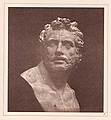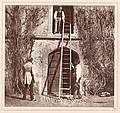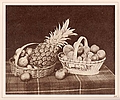Salted paper prints - Summary |
- Salted Paper was the first photographic printing process – published by William Henry Fox Talbot in 1839
- Prints were made using ordinary writing or drawing paper (later, mainly Rives or Saxe papers, noted for their purity.)
- It is a contact printing process - using a same size negative firmly held in contact with the printing paper
- It is a printing-out process - where the image appears during the exposure to light and can be checked visually.
- It uses finely divided crystals of light-sensitive silver salts, produced on the surface of the paper in the sensitising step.
- Almost all salted paper prints were toned to improve colour and density; early toning methods were unreliable.
- Toning using gold toner was widespread from around 1860, giving improved image tone and permanence.
- Salt prints are normally a warm brown, although may also have a purple-brown tint.
- Organic binders, such as gelatine, starch, citric acid or albumen are essential to the process.
- Salted paper prints are matte. Salted paper with sufficient albumen could be made glossy, and glossy salted paper prints are generally considered as 'albumen prints' rather than as salted paper prints.
Salted paper prints - Current use |
Many photographers have made salt prints in recent years, and a number of books give directions for the process.
|





|

